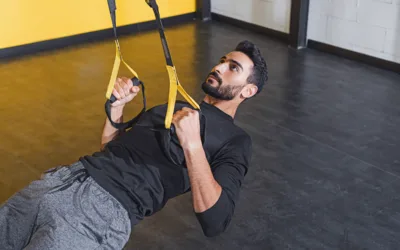3 Ways to Improve Mobility Without Stretching

Are you still trying the endless foam rolling and stretching exercises to get that deep squat position? We know how important mobility is for great, or even GOOD performance. All professional athletes have some comfortability in end ranges of motion. So, what else do they do to improve their mobility?
Brandon Robb is the founder and head coach of HEROIC Athletics @heroic.athletics — he’s worked with athletes for over a decade. First responders (fire, police, military), golfers, Crossfitters, obstacle course racers, and hockey players all turn to him for performance gains, injury prevention, and competition prep.
Brandon Robb

Change the Way You Train
Is Mobility Work Really That Hard?
As a Canadian kid who grew up playing competitive hockey, I was decently strong out of the gates. I had a strong deadlift, could do strict handstand pushups, and was able to bang out the workout “Angie” strict: 100 pull ups, 100 push ups, 100 sit ups & 100 squats. (To be fair, I’m pretty sure this took well over an hour, but I did it…)
But with all that said, I couldn’t squat below parallel to save my life.
Once I accepted the fact that I needed to work on my squat, I got to work. I stretched daily. I foam rolled regularly. I did everything I was told, and while I did improve my squat depth, it came at a cost — I tore my meniscus in my left knee.
The following two years led me down a path to truly understanding the biomechanics of the body.
Why is working on mobility important?
- Your movement efficiency is better.
- Your range of motion for each exercise is deeper.
- You have better control in those deeper ROM.
- You’re less prone to injuries and chronic pain/old injuries can go away.
Why don’t people work on it more?
- They throw a few stretches and foam rolling together to “fix” the issue, not unlike Phil Swift and his Flex Tape commercial
- It’s often boring as hell, and as a result most people follow it haphazardly and don’t give it enough consistency
- There are always other fitness goals to work toward — getting stronger or faster
Let me start with a disclaimer: assess, don’t guess.
In order to TRULY get a protocol that fits you, you should be working with a professional, like a PT. Template programs and subscriptions are great, but nothing will beat ponying up and investing in some 1:1 coaching.
With that said, I have practiced the following three principles on both myself and my clients with overwhelming success. If you can take these principles and apply them consistently to your training, you’ll be well on your way to improving mobility, reducing your injury risk and performing better than you ever have before.
PRINCIPLE 1: Vary Your Warmups
I see the same thing all the time. Athletes walk into the gym and hit the same warm up they’ve been doing for years.
Doing the same (or similar) warm up for every workout can activate parts of your body and brain to “wake you up” for your workout, but it doesn’t necessarily prep the muscles you’ll be using that day.
Instead, what I get my athletes to do is the following:
- 2-3 minute general warm up: sled, cardio machine, etc
- 2-3 bodyweight movements hitting specific muscles for that day’s training
- 2-3 loaded movements hitting the same muscles at different angles
For example, here’s how I would write the warm up/movement prep for a squat day:
3-5 minutes sled push/pull or Zone 2 cardio machine
2-3 rounds:
- 5 per side hip 90/90 transitions
- 8-10 glute bridge V walkouts
- 0:30-0:40 per side long split pulse
3 sets:
- 6-8 per side seated DB good mornings
- 6-8 per side goblet kickstand pistol squat
By warming up this way you bias the relevant muscle groups more. EVERYONE has movement discrepancies, and by hitting these more “obscure” movements in your warm up, you can effectively focus on certain muscles more. When these muscles are activated properly, you’re more likely to use them efficiently and have better mobility.
PRINCIPLE 2: Focus On Your Joints
Most of the time we are taught to emulate the movements we see. But the human body is incredibly smart. More often than not, with enough focus and attention, we can mimic any movement we see. However in doing so, we may not be using the same muscles to the same degree as what someone else is demonstrating.
Without a keen coaching eye, there’s a high chance that you may be compensating by using one muscle or group of muscles more than the others.
How do we fix this? Focus on the joints, not the movement. For every movement/exercise in the gym, ask yourself two questions:
- Does this joint HINGE or ROTATE?
- Is this joint supposed to be STABLE or MOBILE?
Every joint has a role in every movement. That role is dictated by what the joint is built to do and what the joint is actively trying to contribute to the movement itself.
One good way to practice your mechanics at the end ranges for each joint is CARs, or controlled articular rotations. CARs help you focus on moving a joint independently of the rest of your body. This movement awareness can identify joints that have less mobility or more “sticky” points and help you work on them.
PRINCIPLE 3: Incorporate TEMPO
One of the big issues I ran into early in my career was the mantra of “Go hard, go fast.” There is a time and a place for speed, but if that is the whole make up of a training program, you’re asking for an injury and poor mobility.
Purposely slowing down and even holding movements is extremely beneficial to enhance mobility.
Tempo is the slowing down of any movement through its points of muscle contraction. It can be broken down into 4 numbers, with each number representing the time in seconds to perform a portion of a rep. Ex. tempo 42X1
The first number (4) – ECCENTRIC
- The “DOWN” part of a movement
- Lowering of a back squat, lowering of the body in a pull up, lowering the weight to the ground on a deadlift, lowering the bar to your chest on a bench press
- In this case, 4 seconds down
The second number (2) – ISOMETRIC HOLD
- The “HOLD” part of a movement at maximum tension
- Holding the bottom of a squat, the pause at the bottom of a pull up, the time it takes to reset a deadlift with the bar on the ground, the pause of the bar on your chest in a bench press
The third number/letter (X) – CONCENTRIC
- The “UP” part of a movement
- Standing up a back squat, pulling the body up for a pull up, standing up a deadlift, pressing a bar up for a bench press, etc
- NOTE: ‘X’ means explode, or do so as fast as you can, ‘A’ means assisted, and a number represents completing the movement over the course of a given time in seconds
The Fourth number (2) – ISOMETRIC HOLD
- The “HOLD” part of a movement at the reset point of the movement
- The top of a squat before you go into your next rep, the hold of a pull up at the top over the bar, the pause at the top of a deadlift, the pause at the top of a bench press before you move into your next rep, etc.
Incorporating TEMPO into your workouts can help mobility in 2 ways:
- It ensures you perform the movement properly and make adjustments as you complete the movement, which allows you to bias and use stabilizers you may not use as much when training at full speed.
- It creates more “time under tension” which, if movements are being executed at full range, provides more stability in your movement. When you complete similar movements in your job or sport, you are less likely to get injured as you have greater stability through movement.
Keep in mind, I have nothing against stretching and foam rolling. But, if you’ve been doing these things to no avail, changing a few pieces around your workouts may have more impact on improving mobility.
For myself and the athletes I work with, incorporating these elements has significantly improved mobility, reduced injury occurrences, and led to less daily aches and pains. Pick one to try for your next training session.
Find Your Perfect Training Plan
Sometimes all you need to reach your destination on your fitness journey is an expert guide. We've got you covered. Browse from thousands of programs for any goal and every type of athlete.
Try any programming subscription free for 7 days!
Related articles
Working Out During Ramadan: Maintaining & Making Gains
It’s falsely believed by many Muslim athletes that Ramadan = losing progress (gains!). This isn’t the case if you train, fuel, hydrate, and sleep appropriately. Of course that’s easier said than done, but following a few of these strategies can make all the difference...
The Ultimate Low Back Training Guide: Tips for a Stronger Spine
Low back pain sidelines countless athletes and gym-goers. But here’s the truth: your lower back doesn’t need endless isolation work to stay strong. The real secret? A smart mix of direct and indirect training strategies. This guide breaks it all down, giving you...
6 Practical Tips for New S&C Coaches
You’ve got the degree, passed the certs — you're ready to do the job. Your real coaching journey is just beginning. Success isn’t just about knowing the science, it’s about growing as a leader, communicator, and lifelong learner. Here are six tips to help you navigate...

Join the community
Sign up for the latest training news and updates from TrainHeroic
Support
Made with love, sweat, protein isolate and hard work in Denver, CO
© 2023 TrainHeroic, Inc. All rights reserved.






